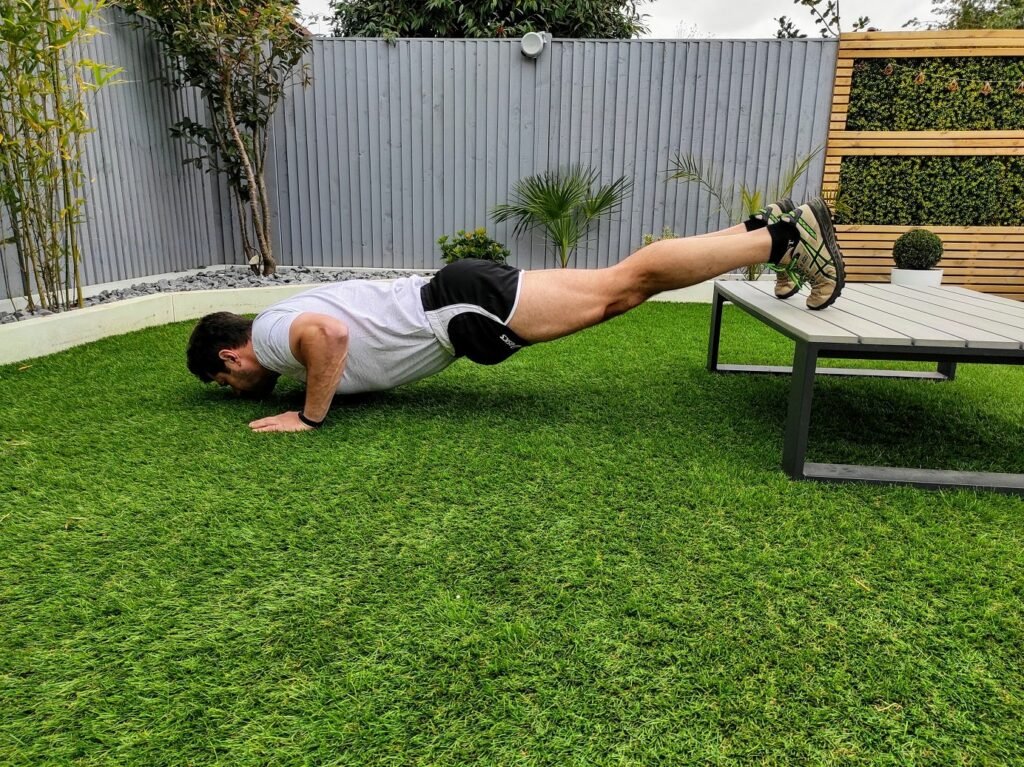The healing time of your shoulder impingement depends on the injured structure, the time your shoulder hurts, and the severity of eventual deficiencies in and around the shoulder joint.
In this article, I discuss all the structures in the shoulder that can get injured and the time the injuries take to heal. Then I’ll provide you with a framework of functional milestones that you can also use to track your healing. With this information, you know exactly if and when you can start rock climbing again.
Let’s dive right in!
1. What is Shoulder Impingement?
Shoulder impingement is shoulder pain due to the impingement of structures between the acromion and the humerus. At least, that’s what the hypothesis was in the ’70s when this diagnosis was developed by a surgeon called Dr. Charles Neer.
Nowadays we know that there are little structures that impinge when you move your shoulder Even when it’s painful and it feels like something is preventing you from moving freely, it can be due to these little structures being impinged
There are a variety of structures that can cause pain in the shoulder. Here’s a list of them:
- The cervical spine
- Muscles of the upper back, shoulder girdle, and upper arm
- Bursas
- Tendons in the shoulder
- Ligaments in the shoulder
- Cartilage
- Capsule
- Nothing
Of all the causes of shoulder pain, the last one is the most interesting. Because even when you can prove with imaging techniques like Magnetic Resonance Imaging (MRI) or Ultrasound Sonography (US) that there’s damage to a structure, this doesn’t necessarily be the origin of your pain.
So, shoulder impingement type of pain can have a variety of origins. Either specific or unspecific to a structure and is thus better called rotator cuff-related pain syndrome (RCRPS), non-specific shoulder pain, or if you’re 100% sure it’s a certain structure call it by its name. For example, bursitis, tendinopathy, or capsulitis.
Now that you have a quick insight into what shoulder impingement is, or better, could be, let’s have a look at how long it takes to heal from it.
I will first discuss the healing time per structure and then show you how to judge the progress of healing by looking at how the shoulder functions.
2. Shoulder Impingement Healing Times by Structure
If there is a specific reason for your shoulder impingement type of pain, then it’s good to know how the healing phases of these types of tissue develop.
The following structures are most likely specific causes of shoulder pain:
- Bursa
- Tendon
- Capsule
- Cartilage
- Muscle
Here’s a global overview of healing times by structure. For your information, this is what the colors mean during rehab:
- Red & Orange: protect your injured tissue. Rest, and only move within a pain-free range.
- Yellow & Light Green start loading the injured tissue. Stretching, active movements and movements with light resistance are allowed. All are guided by your pain and discomfort levels.
- Dark Green: use your tissues, load guided by your pain and discomfort levels and progress to sports.
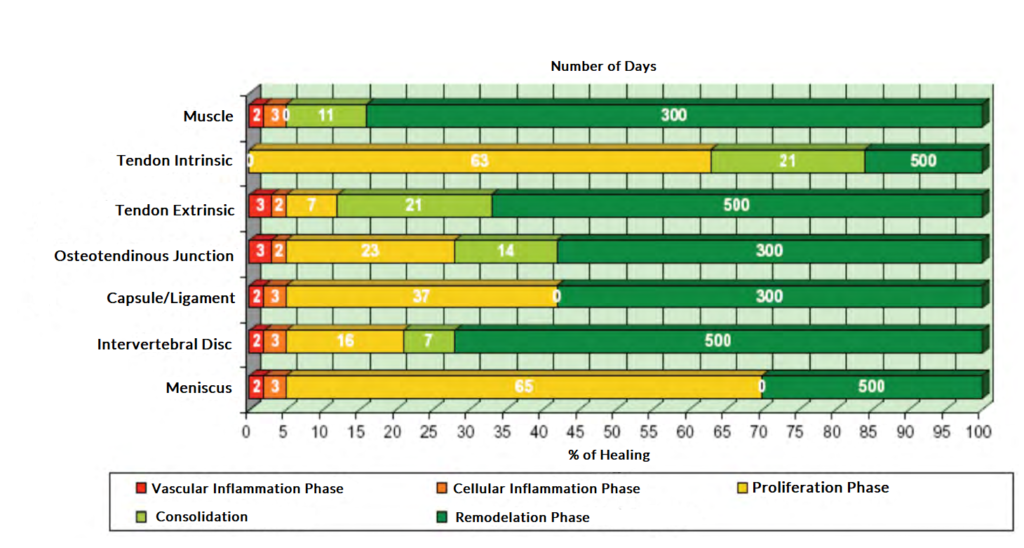
Here’s an overview of each of the structures and how they can cause pain.
2.1 Bursa
A bursa is a sac made of a synovial membrane filled with synovial fluid. This cushion-type structure reduces friction between surfaces.
In the shoulder, two bursas can cause your pain. The subacromial bursa prevents friction between the supraspinatus tendon and the acromion. And the subdeltoid bursa prevents friction between the deltoid muscle and the supraspinatus tendon.
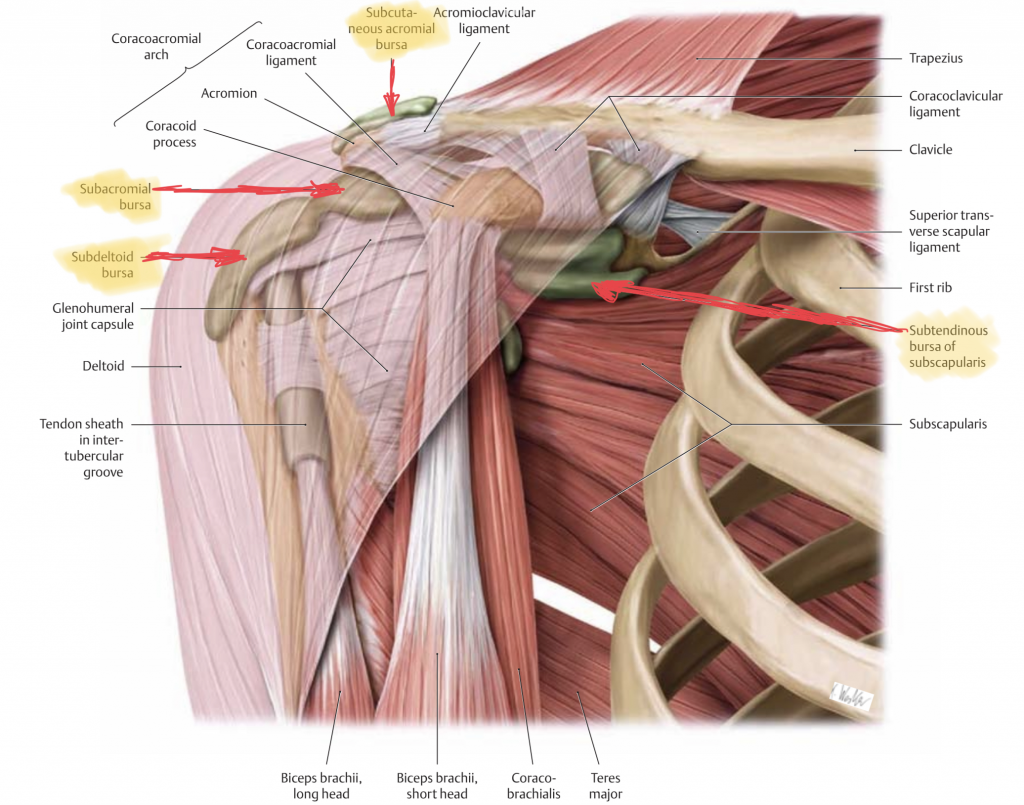
Abnormal friction or an overload of friction can irritate the bursa and cause inflammation. This is called bursitis. As a result, the bursa can increase in size due to swelling, be painful, and limit your range of motion.
A bursa takes between 3-6 months to heal. But in my experience, it’s a difficult structure to treat since the anti-inflammatory medication doesn’t always work. The best results I had were with a combination of Radial Shockwave Therapy and exercises for the rotator cuff.
2.2 Tendon
A tendon is a connection between muscle and bone. It’s stiff, strong, and has little blood circulation. Because of this, it responds slowly to changes in load. A tendon can tear either partially or entirely, or “get sick” which is then called tendinopathy. Another diagnosis that doctors commonly write on the physio-prescription is “calcific tendonitis”. In this case, they saw that the patient has calcium deposits in the supraspinatus tendon for example. Which then should be the cause of their pain.
I think it’s very unlikely that I changed anything about the amount of calcium in the tendons of these patients, still, they all got better. The same is true for lengthwise tendon tears that result from normal aging. And which are very likely to occur on the shoulders of rock climbers. Even though these degenerative tears won’t heal, there’s nothing to worry about. If this causes an acute irritation, you can resolve it with exercises and treating deficiencies in the area around your shoulder.
A tendinopathy can take anywhere from 6-24 months to heal. The healing of a tendon tear is similar.
2.3 Capsule
A capsule or joint capsule is a sack-like a bursa- with a synovial membrane and synovial fluid inside. In the case of a joint capsule though, it keeps two bones together and the synovial fluid nourishes and oils the joint surfaces. In the case of the glenohumeral joint (the shoulder), the rotator cuff is connected to the joint capsule and tenses and stabilizes it.
A joint capsule can stiffen due to a lack of movement. If your shoulder hurts when you lift your arm you might not lift it above your head anymore. If the situation stays like this, your joint capsule gets tight. The capsule, besides containing joint fluid, also limits movement when it’s stiff. This means that when you want to revert a movement limitation you have to stretch not just 1 or 2 minutes, but 10-15 minutes at a time to give the proper signal to where/whom?
Another reason your joint capsule can hurt, and limit your range of motion is due to inflammation, a capsulitis. If this is the case, you need to rest your shoulder for a week and then start moving and stretching it to recover your range of motion. Then a loading program should follow to get your coordination, stability, and strength back.
2.4 Cartilage
Cartilage is a soft type of bone that covers joint surfaces. It prevents friction and absorbs shock forces. Cartilage is either damaged because of an accident, or because of degeneration in the presence of osteoarthritis. High physical activity is a risk factor for osteoarthritis, but so is inactivity. It is commonly referred to as degeneration but that would mean that the more you use a joint the more it degenerates. This is not the case.
After the age of 16, it’s unlikely that cartilage damage will heal. Still, you can train around it and optimize mobility, coordination, stability, strength, and muscle mass in and around the shoulder joint to make the cartilage damage irrelevant.
A special type of cartilage that is worth mentioning is the labrum. This is a cartilage edge that you find around the glenoid (the shoulder socket) which provides extra stability and joint surface. Damages to the labrum due to subluxation of the shoulder are common in rock climbers and are called Superior Labrum Anterior Posterior (SLAP) Tears. These don’t heal either but can be compensated with muscular strength and stability. In severe cases, surgery might be indicated.
2.5 Muscle
Muscles in the shoulder can cause shoulder impingement type of pain in a variety of ways.
First, shoulder impingement type of pain mostly occurs due to a lack of coordination and/or strength of the rotator cuff muscles. Of all the ways the structures I mentioned above can cause pain and discomfort, most have some component of rotator cuff deficiency affecting them. That’s also why I mentioned in the beginning that a better name for shoulder impingement is rotator cuff-related pain syndrome.
Secondly, the muscles in and around the shoulder can strain or tear due to an accident. This can hurt and influence your strength, stability, and range of motion. This type of shoulder pain should be treated like any other muscle injury. And takes anywhere from 3 weeks to 6 months depending on the severity.
Lastly, shoulder pain can also be caused by myofascial trigger points. These are hard knots with tight muscle fibers. These can cause radiating pain in the shoulder, around the shoulder, and down your upper arm. If this is the origin of your shoulder pain, it’ll be gone as soon as the hypertension is gone. This can take anywhere from 1 week to a couple of months.
3. Shoulder Impingement Healing Time According to Function
Even though structural healing times are essential information they’re less relevant for chronic shoulder pain. A better approach is to test for functional milestones. Can you lift your arm overhead? Can you externally rotate your shoulder entirely? And can you hang on your arms? These are among the functional milestones that will give you the necessary information to decide if you can climb or not.
Here’s an overview of the functional milestones and what they mean for your rock climbing. All movements and activities should be pain-free and technically correct. Some, if not all the activities I show below are part of a return to sport protocol we’re developing with Climbing Physio Switzerland.
- Shoulder Flexion 90 degrees: start coordination and stability exercises below shoulder height
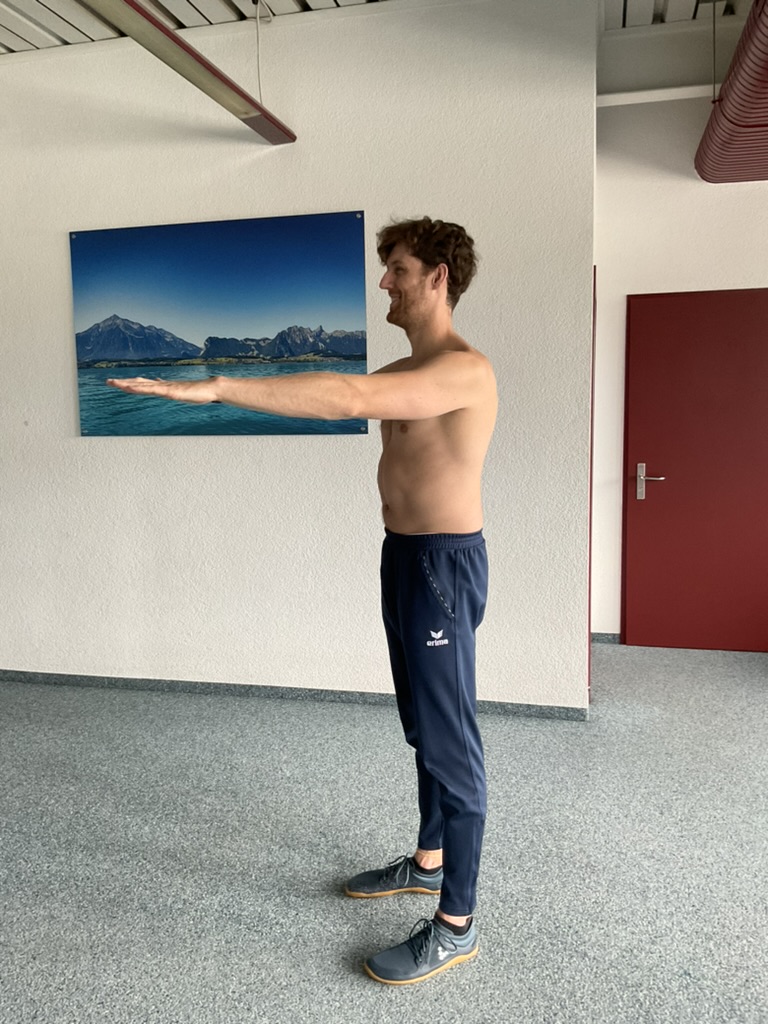
- Shoulder Flexion equal to healthy side: start strength training in all planes
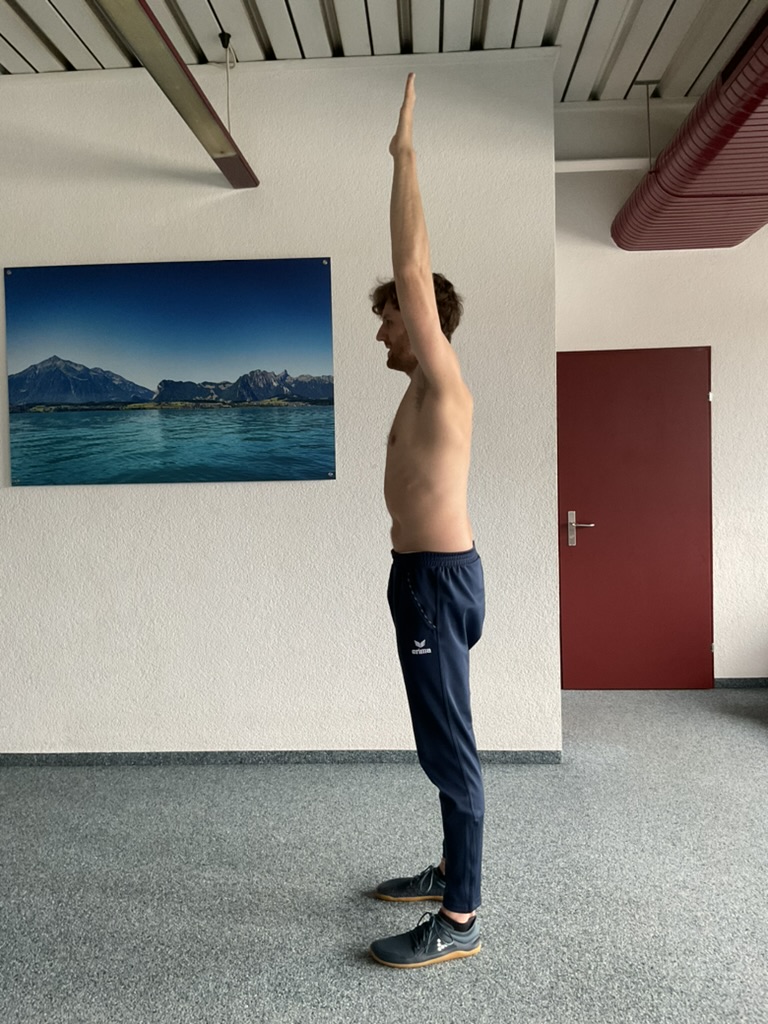
- Hanging 15 seconds horizontally with 2 Arms & Glenohumeral External Rotation equal to healthy side: start rock climbing 4-5 grades below red point level
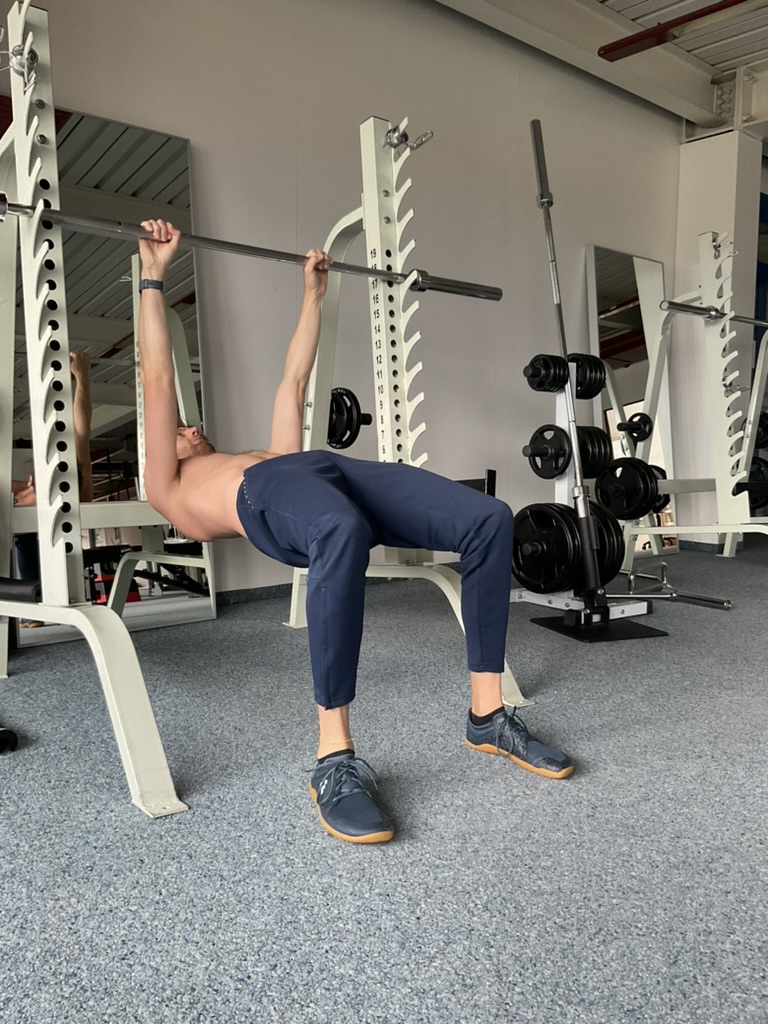
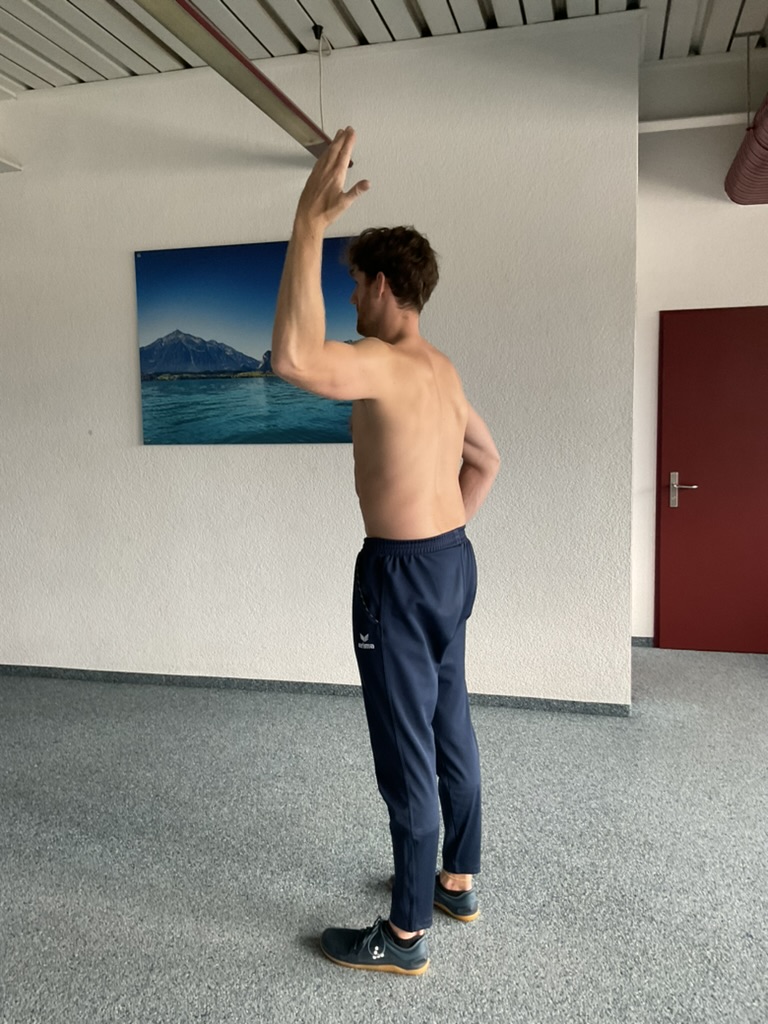
- Hanging 15 seconds horizontally with 1 Arm & Glenohumeral Internal Rotation equal to healthy side: progress rock climbing intensity
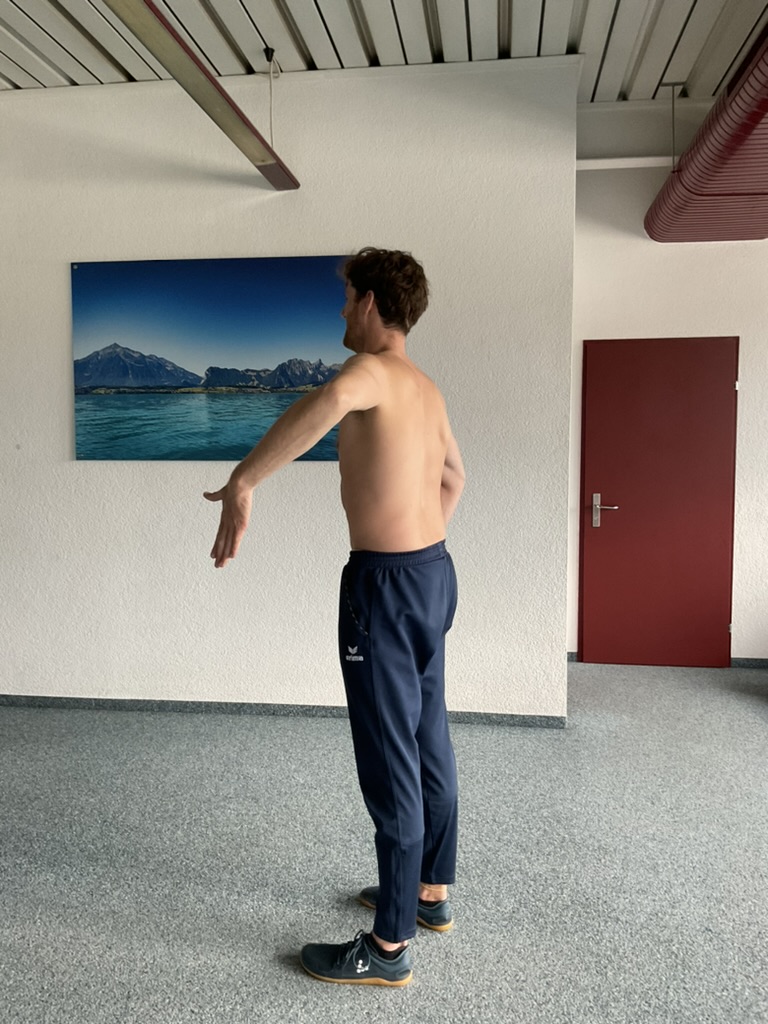
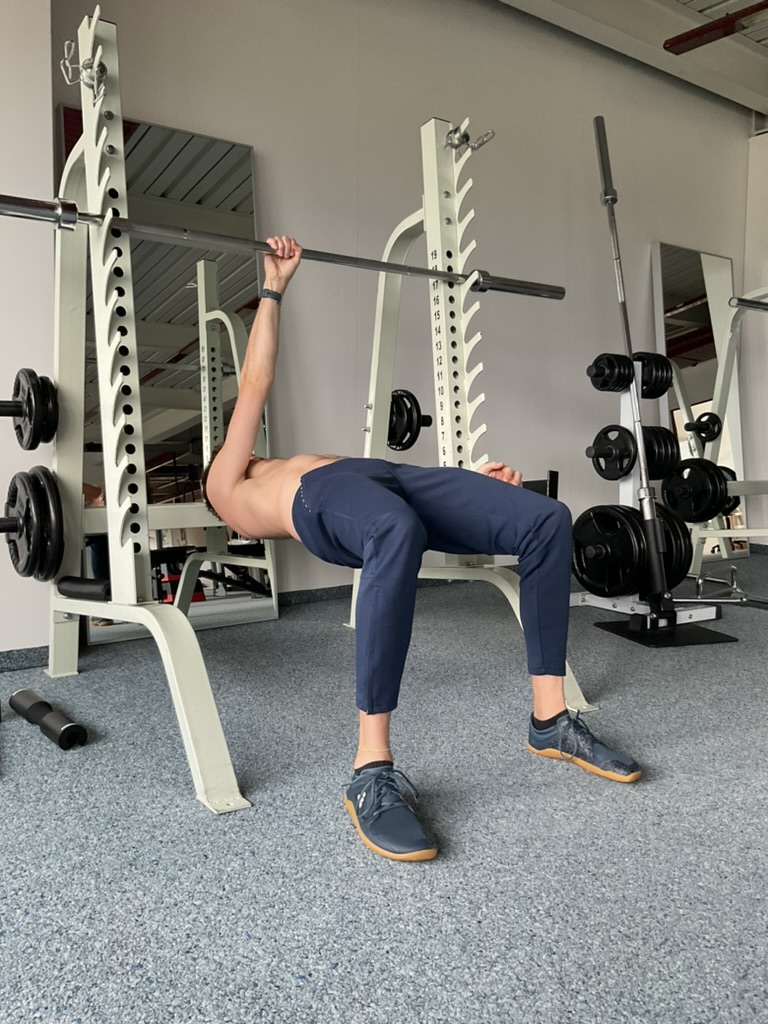
- Hanging 10 seconds with 2 Arms: climb at on sight level, regular finger boarding allowed

- Hanging 10 seconds with 1 Arm: climb at red point level, campus training allowed
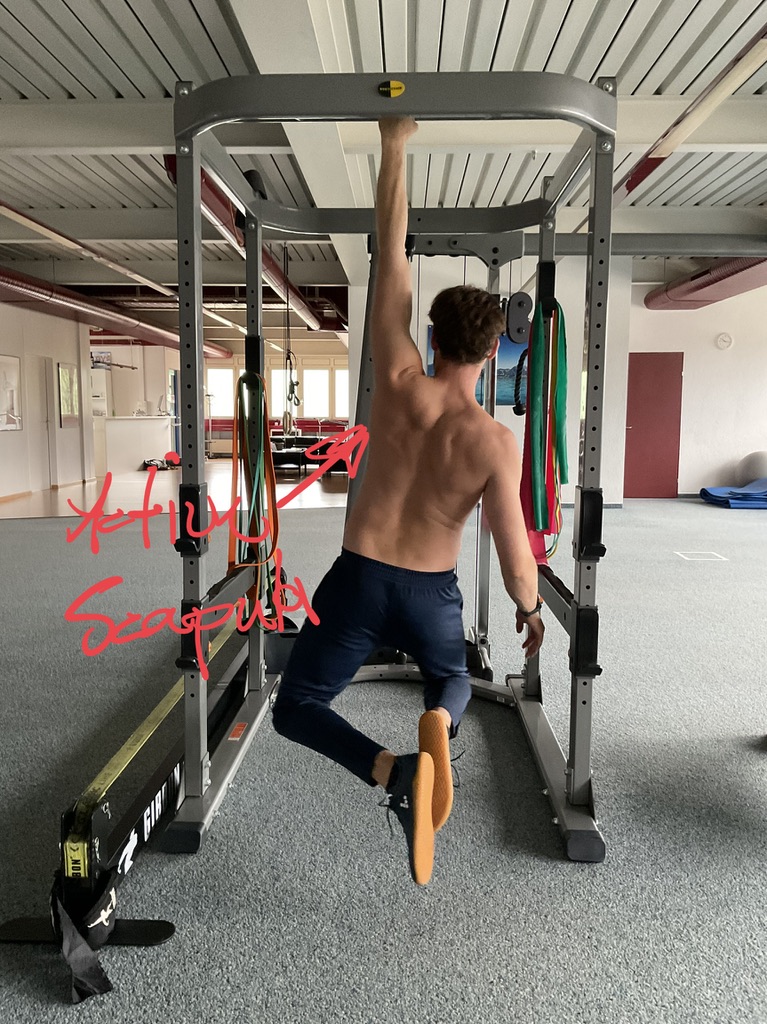
These activities are specific to rock climbing and will give you an indication of your readiness for rock climbing. However, if you manage to do a milestone doesn’t mean you can negate pain during climbing. Never climb with a pain level over 3/10, and never climb at all if the pain is of the stinging and radiating variety. And of course, always ensure proper technique. If you can’t guarantee these things, you’re not ready to climb yet.
4. Important Takeaways
I prefer working with the functional milestones above following the structural healing times. It’s more and more common knowledge that shoulder pain is a complex phenomenon where it’s hard to pinpoint one structure that’s causing the pain. Unless it’s an acute situation in which you subluxated the shoulder or injured a muscle, ligament, or tendon.
Still, I do not negate tissue regeneration phases. I keep them in the back of my mind and trust that if a structure is not ready to move a certain way, it will tell you by hurting. Thus, focus on the functional milestones and take your information from that. If you’re doubting your readiness to return to climbing, you should wait another week and test again. Hurrying back to sports never works in the long run.

